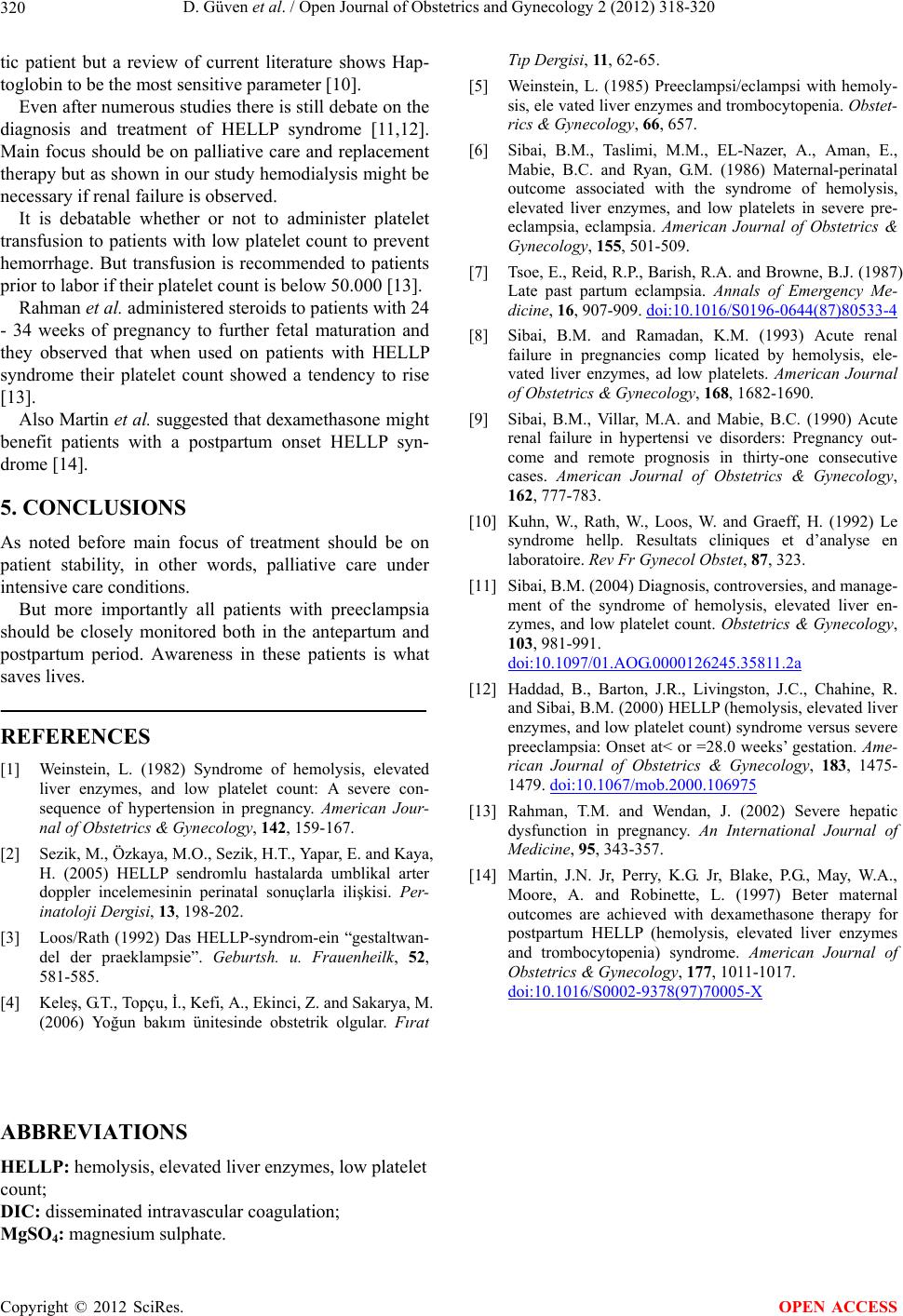
D. Güven et al. / Open Journal of Obstetrics and Gynecology 2 (2012) 318-320
Copyright © 2012 SciRes.
320
tic patient but a review of current literature shows Hap-
toglobin to be the most sensitive parameter [10].
OPEN ACCESS
[6] Sibai, B.M., Taslimi, M.M., EL-Nazer, A., Aman, E.,
Mabie, B.C. and Ryan, G.M. (1986) Maternal-perinatal
outcome associated with the syndrome of hemolysis,
elevated liver enzymes, and low platelets in severe pre-
eclampsia, eclampsia. American Journal of Obstetrics &
Gynecology, 155, 501-509.
Even after numerous studies there is still debate on the
diagnosis and treatment of HELLP syndrome [11,12].
Main focus should be on palliative care and replacement
therapy but as shown in our study hemodialysis might be
necessary if renal failure is observed.
It is debatable whether or not to administer platelet
transfusion to patients with low platelet count to prevent
hemorrhage. But transfusion is recommended to patients
prior to labor if their platelet count is below 50.000 [13].
Rahman et al. administered steroids to patients with 24
- 34 weeks of pregnancy to further fetal maturation and
they observed that when used on patients with HELLP
syndrome their platelet count showed a tendency to rise
[13].
Also Martin et al. suggested that dexamethasone might
benefit patients with a postpartum onset HELLP syn-
drome [14].
5. CONCLUSIONS
As noted before main focus of treatment should be on
patient stability, in other words, palliative care under
intensive care conditions.
But more importantly all patients with preeclampsia
should be closely monitored both in the antepartum and
postpartum period. Awareness in these patients is what
saves lives.
REFERENCES
[1] Weinstein, L. (1982) Syndrome of hemolysis, elevated
liver enzymes, and low platelet count: A severe con-
sequence of hypertension in pregnancy. American Jour-
nal of Obstetrics & Gynecology, 142, 159-167.
[2] Sezik, M., Özkaya, M.O., Sezik, H.T., Yapar, E. and Kaya,
H. (2005) HELLP sendromlu hastalarda umblikal arter
doppler incelemesinin perinatal sonuçlarla ilişkisi. Per-
inatoloji Dergisi, 13, 198-202.
[3] Loos/Rath (1992) Das HELLP-syndrom-ein “gestaltwan-
del der praeklampsie”. Geburtsh. u. Frauenheilk, 52,
581-585.
[4] Keleş, G.T., Topçu, İ., Kefi, A., Ekinci, Z. and Sakarya, M.
(2006) Yoğun bakım ünitesinde obstetrik olgular. Fırat
Tıp Dergisi, 11, 62-65.
[5] Weinstein, L. (1985) Preeclampsi/eclampsi with hemoly-
sis, ele vated liver enzymes and trombocytopenia. Obstet-
rics & Gynecology, 66, 657.
[7] Tsoe, E., Reid, R.P., Barish, R.A. and Browne, B.J. (1987)
Late past partum eclampsia. Annals of Emergency Me-
dicine, 16, 907-909. doi:10.1016/S0196-0644(87)80533-4
[8] Sibai, B.M. and Ramadan, K.M. (1993) Acute renal
failure in pregnancies comp licated by hemolysis, ele-
vated liver enzymes, ad low platelets. American Journal
of Obstetrics & Gynecology, 168, 1682-1690.
[9] Sibai, B.M., Villar, M.A. and Mabie, B.C. (1990) Acute
renal failure in hypertensi ve disorders: Pregnancy out-
come and remote prognosis in thirty-one consecutive
cases. American Journal of Obstetrics & Gynecology,
162, 777-783.
[10] Kuhn, W., Rath, W., Loos, W. and Graeff, H. (1992) Le
syndrome hellp. Resultats cliniques et d’analyse en
laboratoire. Rev Fr Gynecol Obstet, 87, 323.
[11] Sibai, B.M. (2004) Diagnosis, controversies, and manage-
ment of the syndrome of hemolysis, elevated liver en-
zymes, and low platelet count. Obstetrics & Gynecology,
103, 981-991.
doi:10.1097/01.AOG.0000126245.35811.2a
[12] Haddad, B., Barton, J.R., Livingston, J.C., Chahine, R.
and Sibai, B.M. (2000) HELLP (hemolysis, elevated liver
enzymes, and low platelet count) syndrome versus severe
preeclampsia: Onset at< or =28.0 weeks’ gestation. Ame-
rican Journal of Obstetrics & Gynecology, 183, 1475-
1479. doi:10.1067/mob.2000.106975
[13] Rahman, T.M. and Wendan, J. (2002) Severe hepatic
dysfunction in pregnancy. An International Journal of
Medicine, 95, 343-357.
[14] Martin, J.N. Jr, Perry, K.G. Jr, Blake, P.G., May, W.A.,
Moore, A. and Robinette, L. (1997) Beter maternal
outcomes are achieved with dexamethasone therapy for
postpartum HELLP (hemolysis, elevated liver enzymes
and trombocytopenia) syndrome. American Journal of
Obstetrics & Gynecology, 177, 1011-1017.
doi:10.1016/S0002-9378(97)70005-X
ABBREVIATIONS
HELLP: hemolysis, elevated liver enzymes, low platelet
count;
DIC: disseminated intravascular coagulation;
MgSO4: magnesium sulphate.